Specifications:
Cam-track design offers the best versatility
 Left, pickup with cam track; right, cam-less pickup
Left, pickup with cam track; right, cam-less pickup
Versatility has been one of the key criteria when designing the M-Series Balers. Due to a narrow weather window and increasing amounts of difficult crops such as heavy silage, growers do not want to risk losing any more time during the season.
Cam-track technology provides an efficient solution for such needs. The traditional stripper design provides reduced space between the pickup tines and rotor feeder, while the tine motion helps to avoid pinching. The cam-less technology requires long strippers, creating a dead zone between the tines and rotor. Additionally, fixed tines can easily pinch crops in sticky conditions, causing plugs that need to be manually removed.
Looking at potential component wear, cam-track pickup features an 18 percent lower turning speed than the previous generation of balers, while bearings have been implemented on both side of the tine bars. The cam levers are made of forged steel and cam bearing size increased by 36 percent. All of these points guarantee a very long component life.
Standard pickup fits most regular baling conditions
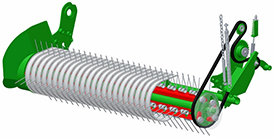 Standard – four tine bars – pickup
Standard – four tine bars – pickup
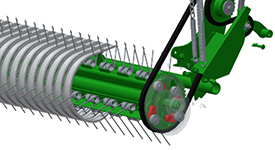 Full-length, L-shaped tine bars
Full-length, L-shaped tine bars
M-Series Balers are available with a standard pickup. Two pickup widths are offered:
- 2.0-m (6.6-ft) standard pickup featuring a 1.66-m (5.45-ft) tine-to-tine distance. This pickup is compatible with the MaxiCut™ HC 13 Premium rotor only, not with the RotoFlow HC Premium.
- 2.2-m (7.2-ft) standard pickup featuring a 1.92-m (6.3-ft) tine-to-tine distance.
Both pickups are designed in a similar way, inspired by well-known 900 Series Balers and using the same components as the M-Series Fixed Chamber Balers:
- Four tine bars
- Full-width, L-shaped galvanized tine bars
- 5.0-mm (0.2-in.) diameter galvanized tines
As for other John Deere round balers, the standard pickup does not need any shear-bolt or cam-clutch protection — tines are designed to fold in case of foreign objects or potential overload. The overall system is globally protected by the tines’ bending capacity; tines have been tested through hundreds of hours of bending and grant extended lifespan. The sealed ball bearings on each side offer a quiet ride for a long period of time.
To give good gliding capacity for years, pickup strippers are made from high-quality galvanized steel that prevents the material from rusting.
The standard pickup design meets most medium to large farms’ expectations, especially for growers who bale mainly dry crops or who harvest some silage.
Premium pickup pushes harvesting capacity a step forward
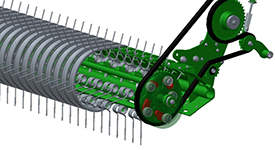 Premium – five tine bars – pickup
Premium – five tine bars – pickup
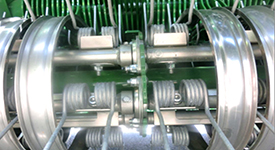 Tine bars made of tube and central spider reinforcement
Tine bars made of tube and central spider reinforcement
For increased pickup capacity and robustness, M-Series Balers can be delivered with the Premium pickup option. Compared to the standard pickup option, the Premium pickup features:
- Five tine bars. The fifth bar allows the tines to rake two more times per second versus standard the four-tine pickup.
- O-shaped tubular tine bars with central spider reinforcement. Tine bars are assembled with ball bearings on the central spider (no more steel-on-steel contact compared to previous-generation balers). The central spider highly limits tine bars bending in the very heavy crops.
- 6.0-mm (0.23-in.) diameter galvanized tines provide doubled tine strength (versus 5.0 mm [0.2 in.]).
- Stainless-steel strippers (versus galvanized ones on the standard pickup). Stainless steel gives highly durable rust protection, perfect gliding capacity no matter the material, and is much more resistant to acid damage caused by usage of additives (e.g. propionic acid).
The Premium pickup has the same rotation speed as standard pickup, meaning that by featuring an additional tine bar, picking capacity is directly increased by 25 percent. John Deere Premium pickup tines are designed to fold to replace potential shear bolt or cam clutch overload safety. Considering 6.0-mm (0.23-in.) diameter tines, pickup maximum intake capacity is pushed up to 18 kW (24 hp), a value not reached by machines using a cam or shear-bolt protected pickup.
To harvest the largest swaths with good operator comfort, the John Deere Premium pickup is 2.2-m (7.2-ft) wide, with a 1.92-m (6.3-ft) tine-to-tine distance. The John Deere Premium pickup is compatible with the RotoFlow HC Premium rotor (non-cutting device) and MaxiCut™ HC13 Premium (13-knife precutter). Due to the maximized picking capacity, this option is recommended for growers baling a significant volume of wet silage or heavy crops.
The M-Series benefits from the proven HC rotor concept featuring an in-line design
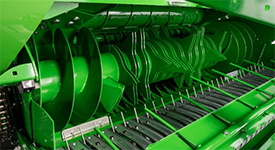 Rotor and converging augers are aligned on a single axle
Rotor and converging augers are aligned on a single axle
 Left, HC rotor; right, classic rotor design
Left, HC rotor; right, classic rotor design
By using the HC Premium rotor – a device implemented on John Deere round balers since 2012 – the M-Series feeding system offers:
- Limited distance from the pickup to the rotor tines to reduce plugging, especially in brittle straw or short silage
- Reduced number of bearings and distributed loads along the rotor to increase reliability
- Large 48-cm (18.9-in.) diameter converging augers to facilitate crop transfer
The overall result is optimized crop flow that avoids all dead area where crops stay for a long time.
This smooth and regular crop flow guarantees high feeding capacity, especially in short crops such as brittle straw or sticky silage.
RotoFlow HC Premium is the perfect solution for non-cutting uses
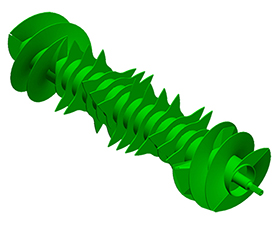 Premium rotor design with tines fully enclosing the tube
Premium rotor design with tines fully enclosing the tube
M-Series Round Balers can be delivered with the RotoFlow HC Premium non-cutting solution. All other John Deere round balers are equipped with a rotor feeder:
- Close to 50-cm (19.7-in.) diameter rotor for high inertia and feeding capacity
- Hardox® wear plate material (similar to the R-Series) provides long lifespan and high resistance to foreign objects (Hardox wear plate tines provide 80 percent or more resistance versus traditional S700 grade steel)
On top of the standard specifications, the premium rotor features:
- Three tines per turn (instead of two on the G-Series RotoFlow HC).
- Tines that fully enclose the tube (instead of spikes on the G-Series RotoFlow HC), giving higher tine resistance and longer lifetime.
The RotoFlow HC Premium design has been used on John Deere variable-chamber balers and has demonstrated unsurpassed capacity (John Deere 900 Series official productivity world record) and very high versatility.
The RotoFlow HC Premium option is available with 2.2-m (7.2-ft) pickup only (standard or premium). This rotor cannot be teamed to a 2-m (6.6-ft) standard pickup.
MaxiCut™ HC 13 Premium offers high versatility, huge capacity, and perfect cutting quality regardless of crop type
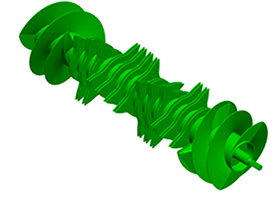 MaxiCut HC 13 Premium rotor
MaxiCut HC 13 Premium rotor
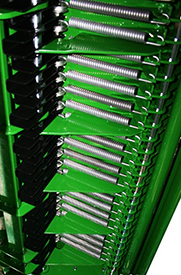 Knives individually protected
Knives individually protected
As an alternative to the RotoFlow HC Premium, M-Series Balers can be delivered with the MaxiCut HC 13 Premium rotor. As with the non-cutting system, the rotor features:
- Close to 50-cm (19.7-in.) diameter rotor for high inertia and feeding capacity
- Hardox wear plate material (similar to the R-Series) to provide long lifespan and high resistance to foreign objects (80 percent or more resistance versus traditional S700 grade steel)
- Three tines per turn (instead of two on the G-Series RotoFlow HC)
- Tines that fully enclose the tube (instead of spikes on the G-Series RotoFlow HC), giving higher tine resistance and longer lifetime
Precutter functions also offer:
- 0/13 knife engagement from the display. No need to leave the cab to manage knives.
- 80-mm (3.1-in.) knife spacing when all knives are engaged, a common cutting length for medium to large livestock farms.
- Heavy-duty knives thanks to double hardening and tempering treatment. Crops are perfectly cut, requiring less fuel consumption and sharpening operations.
- Individually spring-loaded knives to avoid component damages when grabbing foreign objects. Compared to a shear bolt or full-set hydraulic system, this technology limits efforts on the knives and provides a real non-stop safety.
MaxiCut HC 13 Premium is available with both standard and premium pickup, no matter the width.
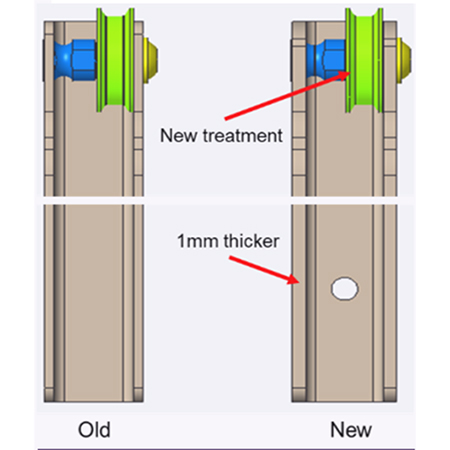 Feeding system
Feeding system
Hardox is a trademark of SSAB Tunnplat AB Limited.
Knife slot fillers for MaxiCut HC Premium pickup without knives
A knife slot fillers set is delivered as standard with all machines featuring the precutter. When using the MaxiCut HC Premium pickup without knives, dust and harvest matter can fill knife slots. This keeps the knives from returning to the cutting position, and plugs must be manually removed to free the knives.
The knife slot fillers take the place of knives when not cutting crops. Drop-floor holes are then filled, allowing quick and easy knife re- engagement. When cutting, the knife slot fillers are stored and locked in a convenient bracket located on the right-side of the baler.
Model year 2024 sees improvements to the feeding system with a new knife lever and roller assembly. The new assembly improves the effective knife engagement process and reduces the amount of cleaning required. This will reduce operator downtime and maintenance of the cutting device.
MaxiCut™ HC 25 Premium delivers extended maintenance interval or fine cut
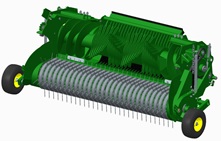 MaxiCut HC 25 Premium rotor with Premium pickup
MaxiCut HC 25 Premium rotor with Premium pickup
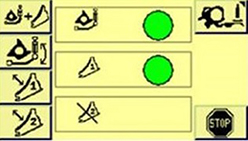 Knives set selection from cab
Knives set selection from cab
MaxiCut HC 25 Premium is a new opportunity for farmers using mid-range round baler. This rotor, directly re-using V4X1R components and featuring same characteristics than MaxiCut HC13 Premium offers two independent set of knives:
- User can then easily switch from the display from one knife set to the other, reducing need for frequent knife maintenance (sharpening).
- Both sets of knives could be used simultaneously to achieve a 40 mm space between knives.
When using both set of knives simultaneously (25 knives engaged), depending of field and crop conditions, the power absorbed by the cutting unit can significantly raise compared to operating with a single set of knives (13 knives engaged). This could result to a noticeable reduction of operating speed in the field.
To deliver best user experience, MaxiCut HC 25 Premium option can only be teamed to Premium pickup and ISOBUS baler capacity.
MaxiCut HC 25 Premium option is available for Germany and Austria only.
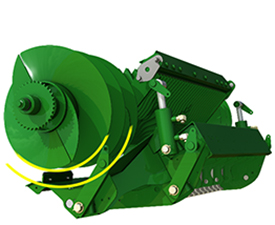 40-mm (1.6-in.) free space under the rotor
40-mm (1.6-in.) free space under the rotor
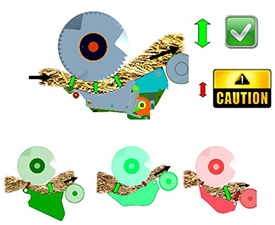 Parallel kinematic avoids bottleneck noticed with other concepts
Parallel kinematic avoids bottleneck noticed with other concepts
M-Series Balers are delivered standard with a drop-floor unplugging system. In case of a clog, the drop floor is managed from the display simultaneously or independently from the knives. When lowering the floor, the parallel kinematic has 40-mm (1.6-in.) extra free space under the rotor and converging augers.
By providing a constant free space, the John Deere drop floor avoids bottlenecks existing on balers using a movable floor with front or rear hinge. No need to have a huge opening (that sometimes causes crop loss), only a few free centimeters (inches) are enough to remove the plug.
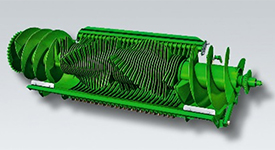 Full-width drop floor removes clogs under converging augers
Full-width drop floor removes clogs under converging augers
The worst plugs generally happen when turning with the baler. In such situations, the crops are blocked under the converging augers and the clog must be manually removed. The unique John Deere drop floor features a full width, protecting the full pickup and rotor width. Even when plugged at the converging auger level, the clog can be easily removed by the operator from the cab.
Bales up to 1.65-m (5.4-ft) diameter maximizes weight
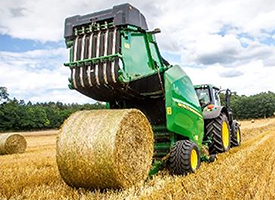 1.65-m (5.4-ft) x 1.21-m (3.97-ft) bales are heavy weight
1.65-m (5.4-ft) x 1.21-m (3.97-ft) bales are heavy weight
As with the other G-, M-, and R-Series Balers, the V451M Baler features a 1.21-m (3.97-ft) bale chamber width. Compared to previous generation balers with similar bale diameters, bales are up to 3.6 percent larger than before. Considering the slightly larger bales have a similar density, that is a huge advantage.
The bale diameter on the V451M Baler can be adjusted from 1.0 m (3.3 ft) to 1.65 m (5.4 ft) using the monitor. The maximum diameter of 1.65 m (5.4 ft) is an added 10 cm (3.9 in.) compared to the previous generation. This allows the grower to produce bales up to 17 percent larger than previous 854 and facilitates production of similar 1.60-m (5.25-ft) hay and straw bales.
Bale diameter progress can be followed from the monitor no matter the display choice.
High density provided regardless of bale diameter
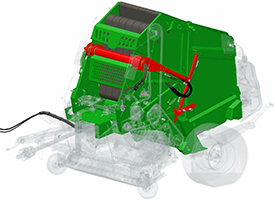 Dedicated cylinders for tailgate and density system plus mechanical tailgate lock
Dedicated cylinders for tailgate and density system plus mechanical tailgate lock
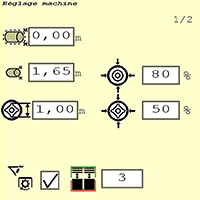 Density is set and controlled from the monitor when using Implement Display 1100
Density is set and controlled from the monitor when using Implement Display 1100
The V451M bale chamber provides high-density bales regardless of the bale diameter or crop type. A dedicated pair of cylinders apply strength to the density arm while mechanical hooks firmly lock the tailgate in the closed position. Another pair of cylinders manages the tailgate opening/closing and avoids potential interferences between the two functions and tension loss to the belts. When the baler features an Implement Display 1100 or other ISOBUS display, the following pressure parameters can be adjusted/controlled from the display:
- Overall bale density settings
- Overall bale density control (virtual manometer on the screen)
- Softcore activation/deactivation
- Softcore diameter (from 1 m [3.3 ft])
- Softcore pressure (0 to 100 percent of maximum density capacity) and softcore diameter
When the baler is equipped with the BaleTrak™ Plus display, the following pressure parameters can be adjusted/controlled from the display:
- Softcore activation/deactivation
- Softcore diameter (from 1.0 m [3.3 ft])
With BaleTrak Plus display, bale density is easily set from the baler hydraulic valve by a knob, a simple but efficient solution for operators not changing hydraulic settings several times a day. Bale density can be controlled from the cab using a hydraulic gauge on front of the baler.
Softcore density cannot be adjusted. The system removes the full hydraulic pressure into to the density harness.
By providing a loose bale core, softcore function is particularly helpful when baling hay that has residual moisture or when unrolling bales by hand.
Bale chamber design optimizes machine versatility
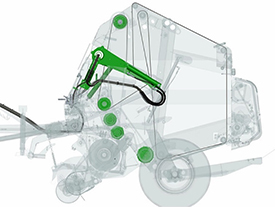 Three bale chamber rolls facilitate bale rotation
Three bale chamber rolls facilitate bale rotation
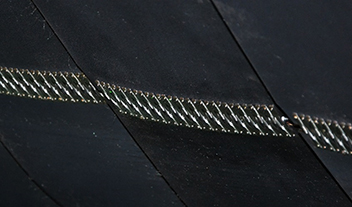 Laced belts can be changed or repaired quickly and for limited cost
Laced belts can be changed or repaired quickly and for limited cost
The V451M bale chamber features a starter roll and two front rolls, all driven, for quick crop rotation whether harvesting short silage or brittle crops.
Easy bale starting is provided by the three rolls, avoiding the aggressive belt pattern that often causes crop accumulation. The six belts – derived from traditional diamond John Deere belts – keep the three plies but adopt a smooth pattern. This pattern (similar to R-Series Balers) is almost not sensitive to wear.
The belts are all joined thanks to proven and durable MATO® type lacers. In case of trouble, belts can be easily removed and repaired, something not possible with an endless belt design.
Due to initial empty bale chamber geometry, V451M Balers feature a star-shaped core comparable to the one offered by fixed-chamber balers. This starred shape guarantees easy bale unrolling, regardless of density settings.
Second belt-driving roll pushes silage baling capacity a step forward
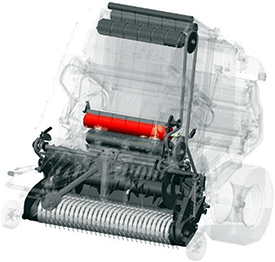 Second belt-driving roll
Second belt-driving roll
The V451M can be equipped with a second belt-driving roll, providing extra grip when baling wet crops such as heavy silage. In such conditions, this second roll prevents belt slipping and allows the belts to turn in the worst conditions.
The second belt-driving roll is made of metal and is driven through normal chain tracking. No extra chains or complicated clutch systems are required to drive the roll. Thanks to a freewheel, the second belt-driving roll is only activated in case of belt slippage.
The second belt-driving roll is an option with the RotoFlow HC Premium feeding system, while it is installed standard with precutter. Two cleaning rollers are also included in the option and keep the crops from sticking on the belts and causing belt slippage.
A second belt-driving roll is also offered as an attachment through the traditional field kit channel.
MATO is a trademark of MATO GmbH & Co.

